It’s rare you hear somebody recommend Wikipedia as a formal source of information—well, publicly, at least—and especially not as a resource for travel planning. However, the web’s free encyclopedia offers detailed information on every major airport (and most minor ones) in the world. That info includes all the global destinations that can be reached directly from those airports and the airlines that can take you there. If you’re trying to map out optimal ways to use your frequent-flier miles, you’ll find those details especially pertinent.
The ITA Matrix software used by Google Flights shows everywhere in the world you can travel from a particular airport—and for how much. With a click of a button (and a few tricks), you can populate an interactive destination map that shows you all your global options to help you decide where to go next. You can also monitor fares for specific flights and get alerts when prices go up or down.
Together, Wikipedia and Google Flights are powerful travel-planning tools if used properly. Here’s how to take advantage of both.
Wikipedia’s “Airlines and Destinations”
Every airport listed on Wikipedia includes a subheading, “Airlines and Destinations,” where you’ll discover which airlines serve the airport in question and which destinations can be reached directly from that airport. This may sound like elementary information, but it’s a great resource for those wanting to know options for nonstop flights and possibilities for mileage redemptions.
Let’s clarify with some real-life examples. Four of us want to visit my cousin in Charleston for Memorial Day weekend 2024—ideally using miles. Thankfully, Charleston has its own airport a short ride from the city center, Charleston International Airport (CHS). We live in South Florida, and the family doesn’t like connecting flights.
Once I’m on the Charleston International Airport page on Wikipedia, I click on “Airlines and Destinations” from the Contents menu (on the left-hand side), which reveals a table with the airlines flying in and out of Charleston, plus all the cities with direct flights. To quickly find if there are any direct flights to/from Miami, I do a Control-F Search for “Miami,” and I find that American Airlines/American Eagle fly nonstop between Miami International Airport (MIA) and Charleston. I do the same for “Fort Lauderdale” and see JetBlue and Spirit Airlines are the two options if we want to fly from Fort Lauderdale–Hollywood International Airport (FLL).
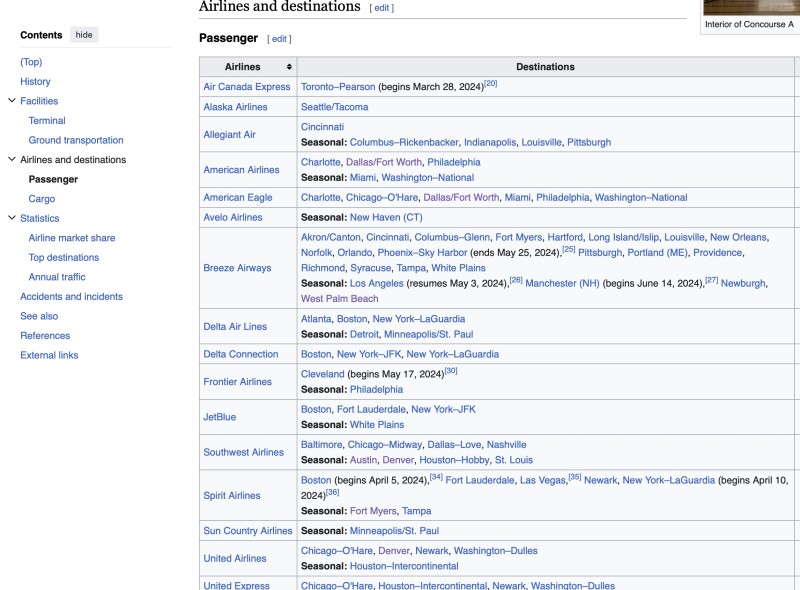
These are the airlines that fly to Charleston International Airport and the nonstop destinations they serve.
Courtesy of Wikipedia
I now know there are several options for cash tickets as well as possible points redemptions. Next, I go to Google Flights and check prices for cash tickets between MIA or FLL and CHS from May 24 to May 27, choosing “nonstop” options only (from the selection of filters). The cheapest flight is on American Airlines for $187 in Basic Economy round-trip per person or $247 in Main. Meanwhile, JetBlue comes in at $293 round-trip in Basic Blue and $317 in Blue, and Spirit has an option for $283.
Now, it’s time to price the tickets in miles. I go to the websites of AA, JetBlue, and Spirit to check the mileage redemption rates and find them on par with cash prices through their respective loyalty programs: 21,500 miles per person on AA, 21,600 on JetBlue, and 27,000 on Spirit, each with $11.20 in taxes. Knowing that AA has many airline and loyalty-program partners, I go a step further and explore mileage rates on AA through the program of oneworld partner airline British Airways. I find the same itinerary from Miami to Charleston for 16,500 British Airways Avios (points) plus $11.20 in taxes (vs. cash price of about $247). British Airways Avios are easy to obtain since they are a transfer partner of American Express Membership Rewards, Chase Ultimate Rewards, and Capital One. The transfer ratio is typically 1 credit card point to 1 Avios, but I tend to move points during yearly promotions in which transfer ratios escalate as high as 1:1.3. So, currently, I have plenty of Avios. Therefore, I end up booking the tickets with Avios and essentially pay less than 13,000 points per ticket (16,500/1.3) for a total of 52,000 points plus $45 in taxes for a party of four, instead of $988.
As another example, my friend has relocated to Mérida, Mexico, for work. She’s already trying to plan quick weekend getaways but doesn’t know where she can go directly and easily from this small city. The Wikipedia page for Mérida International Airport shows she has some options, mainly within Mexico, but also to Atlanta, Guatemala, Miami, and Texas.
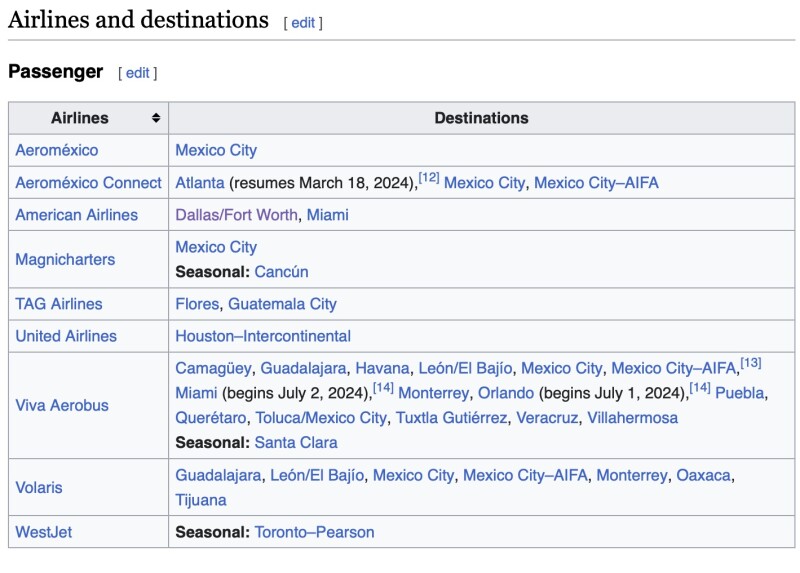
These are the airlines that fly into Mérida International Airport in Mexico and the nonstop destinations they serve.
Courtesy of Wikipedia
Wikipedia typically has the most up-to-date information on seasonal and upcoming flight routes
Wikipedia can also give insight into which routes are seasonal and which are currently suspended. Even better, within the same “Airlines and Destinations” section, you can discover new routes as soon as they are announced and when they are set to commence. On the flip side, you can see which flight routes will end and when.

A partial screenshot of Orlando International Airport’s Wikipedia page reveals when new routes start and when others end service.
Courtesy of Wikipedia
For example, a quick search in early March 2024 of Orlando International Airport (MCO) reveals that in June 2024, charter airline Iberojet will begin flying from Madrid, and LATAM will resume seasonal flights to Santiago de Chile. Also in June, Southwest is introducing several international routes from MCO, including to Cancun, Grand Cayman, Nassau in the Bahamas, Providenciales in Turks and Caicos, Punta Cana in the Dominican Republic, and San José, Costa Rica. The direct flight from Orlando to Pensacola on Silver Airways will cease operations on March 4, 2024.
The Southwest information is especially pertinent for Orlando residents and even more so for Companion Pass holders, who will now be able to bring a plus one for just the taxes on a half-dozen new international routes. Additionally, as many legacy airlines tend to release mileage award seats on new or seasonal routes far in advance, it’s worth checking for deals—especially in business class. Given LATAM’s reboot of its MCO–SCL (Orlando to Santiage de Chile) flight, let’s price out a July trip in business class. If you buy that ticket in cash, it’ll cost you $3,058 round-trip. But let’s look at LATAM’s award availability, which can be easily discovered through the mileage search options of its partner Alaska Air. On Alaska’s website, the same round-trip in business is 90,000 Alaska Miles plus $75. That’s an impressive use of miles!
Maximizing Google Flight’s ITA Matrix Software
ITA Matrix software powers Google Flights, where a simplified, user-friendly version of the software makes it easy for consumers to find the best fares. On Google Flights, you can type in your origin and destination and find the cheapest one-way, round-trip, and multicity fares typically 330 days into the future. An interactive calendar allows you to explore date ranges and lowest fares by airport code, city, or nearby airport.
However, beyond searching specific flight routes, you can assess broader trip options and price them out with Google Flight’s interactive map. On the Google Flights home page, simply type your departure airport, but don’t fill in the arrival airport. Put in your desired dates and hit search. You will see where you can go during your desired dates and for how much. You can then filter by nonstop, airline, duration, and more. Move your mouse around the interactive map and discover destinations and prices across the globe. (Note: While almost every airline has been completely incorporated into the ITA Matrix software, Southwest Airlines, Frontier, and Allegiant Air have not, meaning that they will populate as options but that tickets cannot be purchased directly through Google Flights.)
Let’s say you are based in New York City and know you want to end summer on a high note in Europe but don’t know exactly where yet (and flight price is a factor you are considering). We enter August 24 to September 2, 2024 (the last week of August, with a return on Labor Day) from JFK and find plenty of options under $650 round-trip, with Dublin as low as $440 and Rome from $560.
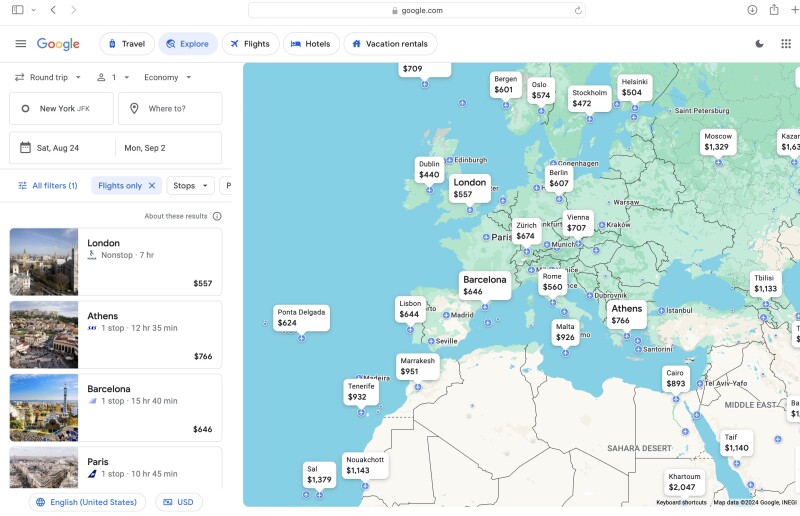
A March 2024 Google Flights search showed affordable round trips to Europe the week before Labor Day.
Courtesy of Google Flights
Or let’s say you’re open to going to Europe anytime in the next six months. You work from home, you’ll go anywhere if the price is right, and you have total flexibility on dates. Search broadly by typing in your departure airport but no arrival airport and no dates, and on the right-hand side below the dates field, click where it says, “Explore Destinations.”
This redirects to an interactive Google Flights map where you can explore flexible dates, date ranges (up to six months into the future), and durations. Choose among a weekend trip, one week, or two weeks (though sometimes results add or subtract a day or two), then specify a month or choose all months, and voilà: Google will reveal the cheapest options based on your search. My search from New York City reveals a round-trip ticket to Berlin for only $366 in the coming months. I click on the price icon on the Google Map and see it’s a nonstop flight from Sunday to Sunday, May 5 to May 12, 2024.
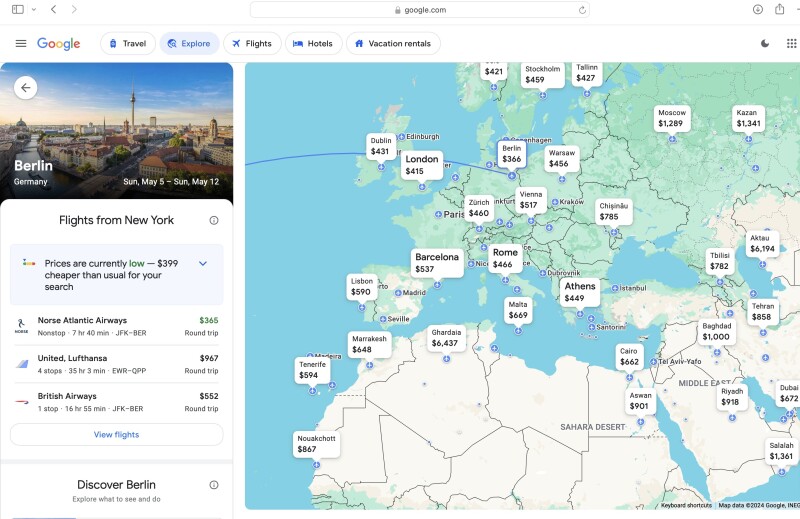
Searching for a one-week trip over the next six months from NYC to Europe on Google Flights.
Courtesy of Google Flights
I wasn’t planning on going to Berlin, but the flight is so cheap, and I’d rather avoid Europe’s summer crowds. I start looking at things to do in Berlin, practicing my best Heidi Klum impression, and decide it was fate that I found this flight. Sold for $366!
Tracking prices on Google Flights
Another powerful tool embedded within Google Flights is price tracking. This is especially useful if you have your eye on specific flight routes over specific days. You’ll need to have a Google account to maximize this feature, be signed into your Google account, and give Google permission to email you price changes (which just requires the click of a button).
Say I don’t want to do the Charleston trip and instead want to head from Miami to Los Angeles for Memorial Day. I enter the information in the appropriate fields and add the dates May 24 to 27, 2024. Once Google Flights lists my options, I choose early-morning flights on JetBlue, both going and returning. After I’ve selected my ideal flights, I have an option in the top right corner to “Track Prices.” I simply hit the button and am now subscribed to receive email alerts when prices change. Google Flights also offers the option for me to monitor prices of similar flights, which I do.

Subscribe to track flight prices on Google Flights.
Courtesy of Google Flights
From that moment forward, Google Flights will track those flight prices until the flight date or when I request to stop tracking, whichever comes first. You can track prices for as many flights as you’d like, and they will be organized by date under “Tracked flight prices,” accessible through the contents bar in the top left-hand corner of the Google Flights home page. Easy-to-digest graphs will show you how prices have gone up and down over time.
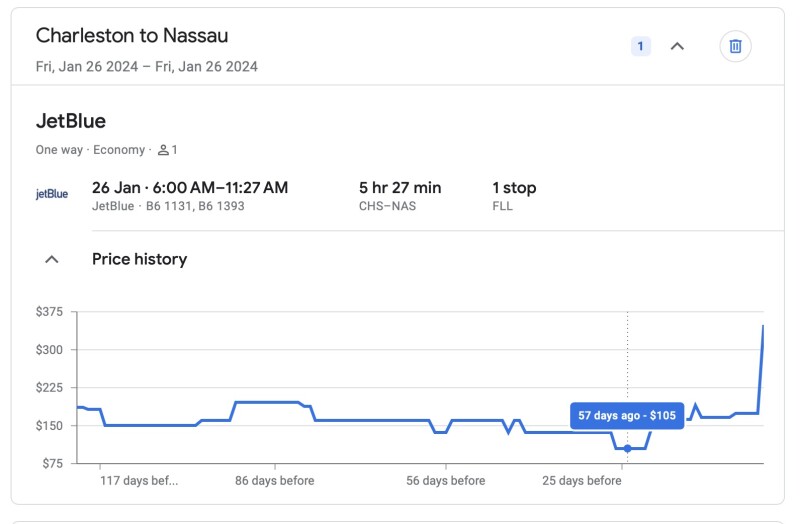
Google Flights will track prices until you opt out or until the flight date.
Courtesy of Google Flights
Sometimes you’ll want to use Google Flights to monitor fares until they possibly reach your target price. Depending on the airline and its policies, you may also want to use Google Flights after you’ve purchased flights to get fare adjustments. For example, I purchased a JetBlue ticket from Charleston to Nassau for $226 in summer 2023 (Blue Basic fare of $186). I was notified of a price drop three weeks later, then of another in December 2023, to $145 in Blue ($105 in Blue Basic). In both cases, I was able to get the fare adjustment back as Travel Bank credits with JetBlue. (Note that I purchase Blue fares as they have no change fees, but cheaper Blue Basic fares do.) All I had to do for my price refund was go to “Manage my Reservation” on JetBlue.com, change the flights to the same ones but at the lower fare, and done! Naturally, JetBlue isn’t going to send me emails of price drops for fares already purchased, but Google Flights will. Then it’s up to me to score the difference. While the “Track Prices” feature is great, it’s not without fault. There have been many times when I have not received email alerts of price drops (though subscribed), so I’d recommend still checking in on those flight price graphs from time to time. If this sounds tedious, trust me, it is.
As a side note, those who can’t be bothered to track prices and request price-drop refunds (like me) should consider booking flights through Capital One Travel on a Capital One Venture credit card. The site monitors price drops and automatically issues statement credits when they occur.
Takeaways
By understanding and using the power of Google Flights and Wikipedia, you can figure out how to get where directly and cost-effectively and even map out trips around the world, connecting the dots in between. It may take a bit of practice, but soon you’ll find these are two of the most powerful travel-planning tools available.
When you’ve mastered these two and are looking for another supplementary tool, you can learn more about how Kayak Direct can help you figure out how to reach nonstop destinations cost-effectively.
This article was originally published in 2022; it was most recently updated on March 9, 2024, with current information.








